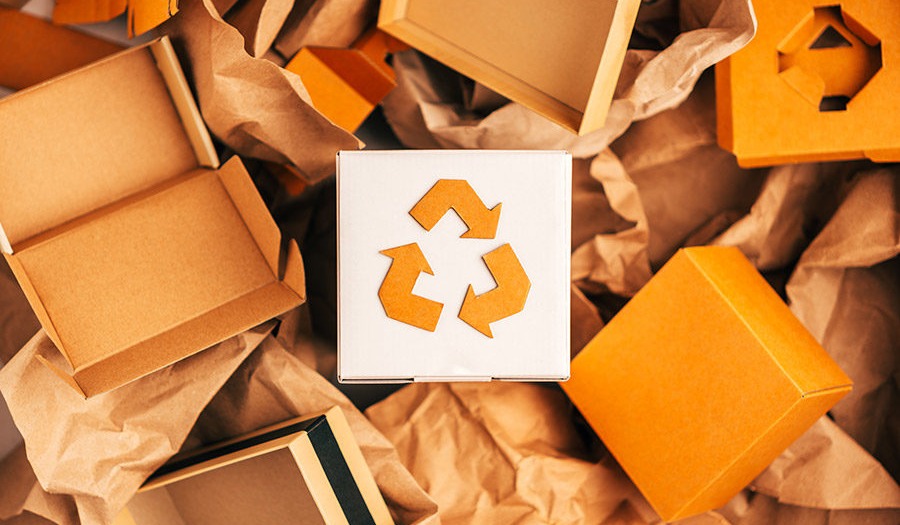
Trends in Sustainable Packaging Design
With 64% of consumers now considering the sustainability and environmental impact of a company’s practice before purchasing, it’s good to be green—and imperative to invest in sustainable packaging that communicates your eco-friendly position.
Buyers today want more from brands than names and logos, they want action. Consumers are calling out for change with their purchasing dollars, and businesses are answering the call.
Coca Cola Company has announced its goal to make 100% of its packaging recyclable globally by 2025. Multinational clothing company, H&M, has switched its in-store plastic bags for paper ones. Big-box retailer IKEA has shifted to a circular business model and aims to design all products using only renewable or recycled materials by 2030.
Brands are switching to eco-friendly alternative solutions with good reason. According to logistics services provider Dotcom Distribution, 64% of buyers have taken the sustainability and environmental impact of a company's practices into consideration in the decision making process behind a purchase—and Forbes states that 88% of buyers now want businesses to help them make a difference with their purchase.
The eco-conscious, socially responsible consumer is no longer a niche market, they are the market. Today’s buyer supports long-term ecological balance, and among environmental factors such as ethical sourcing, fuel efficiency and product ingredients, sustainable packaging was cited as the “most attractive feature” at 45 percent, according to Dotcom Distribution.
Discover what’s possible in sustainable packaging and what to consider throughout the packaging design and production process to ensure your brand stands out as one to buy from—a business who delivers on the promise of sustainability that modern consumers expect.
Primary Packaging: Rethink Your Container
The high-performance, plant-based hair care company, Aveda, with nearly 90% of all retail and professional plastic bottles made with 80% or greater post-consumer recycled material, continues at the forefront of sustainable product packaging innovation.
Aveda recently launched its first-ever, paper-based, locally recyclable sachet. In addition to being curbside recyclable by European and UK consumers at the end of life, the sachets were designed with sustainability in mind and a calculated reduction of 36% to 68% in water consumption and 37% to 64% in emissions compared to multilaminate sachets commonly used in the industry.
- Nature Valley Crunchy granola bars introduced fully recyclable plastic wrappers, a first for the category, made with polyethylene polymers. General Mills did not patent the wrapper and welcomes other food brands to apply the technology to their product portfolios.
- Johnny Walker scotch whisky will debut its 100% plastic-free, paper-based spirits bottle made entirely from sustainably sourced wood, created by Pulpex Limited, a sustainable packaging technology company; PepsiCo expects to pilot branded paper bottles with Pulpex’s technology.
- Sustainable packaging company, Frugalpac, launched the Frugal Bottle, a wine bottle with packaging made from 94% recycled paperboard, a carbon footprint 84% lower than a glass bottle, and a water footprint roughly four times smaller than glass.
Secondary Packaging: Make Your Box Matter
Carefully optimized secondary packaging is a critical aspect of how brands communicate their eco-conscious position to consumers today. A well-designed package that surprises or delights can add distinction, reinforce the positioning of an upscale or luxury brand, and build awareness of the company’s sustainability efforts.
According to a recent Packaging and Sustainability insights study, conducted by WestRock, which surveyed 2,400 U.S. consumers about their attitudes toward environmental issues and sustainable packaging and behaviors:
- 3 out of 4 consumers believe materials used in packaging are an important way companies can show their interest in environmental concerns and sustainability
- 62% said packaging that is designed to be recyclable, reusable, or biodegradable helps build trust in a product
- Paper-based packaging is perceived to be more positive for the environment and can lead to higher brand likability relative to plastic or foam materials
When it comes to sustainable secondary packaging materials, paper offers great recyclability (it can be recycled up to seven times before the fibers are too weak to make into paper again) and paper-based substrates offer much in the way of alternative fibers including bagasse, cotton, straw, and hemp. North American paper makers like Neenah, Mohawk, and French Paper all manufacture products with alternative fibers suitable for commercial print and folding board applications.
Master Cartons: Ship It Sustainably
- One of the biggest culprits when it comes to packaging’s environmental impact is in shipping —from producer, through retailer, and onto consumer—a process which can involve significant quantities of expensive packaging materials, according to GreenBusinessBureau.com.
- Businesses can now incorporate less expensive, biodegradable air packaging peanuts in place of Styrofoam®, and cornstarch-, seaweed-, and even mushroom-based packaging alternatives are gaining ground. Corrugated cardboard packaging, however, remains the gold standard in the green industry. Made from wood pulp, a biodegradable substance, corrugated boxes are fully compostable and recyclable, and most are composed of 70% to 100% recycled material.
At a time when a company’s environmental footprint is almost as closely scrutinized as its bottom line, it’s good to be green—and imperative that your sustainable packaging communicates your eco-friendly position.
To discover more about sustainable packaging and design options for your business today, Just ask. Contact a Millcraft packaging specialist today.
Written by: Jen W. O'Deay
Source List:
88% Of Consumers Want You To Help Them Make A Difference
https://www.forbes.com/sites/solitairetownsend/2018/11/21/consumers-want-you-to-help-them-make-a-difference/?sh=68fceaf36954
H&M
https://www.commonobjective.co/article/how-sustainable-is-paper-and-cardboard-packaging
IKEA
https://about.ikea.com/en/sustainability
Dotcom Distribution:64%
https://www.ogoship.com/blog/green-options-for-online-stores
Dotcom Distribution:45%
https://wwd.com/business-news/retail/dotcom-report-1234838375/
https://www.automationworld.com/home/article/21578331/consumer-preferences-for-ecommerce-packaging
Aveda
https://www.americansalon.com/business/aveda-reaches-new-sustainable-packaging-milestone
Nature Valley, Johnny Walker, Coke, Pepsi
https://www.fooddive.com/news/8-sustainable-packaging-innovations-for-food-and-beverages/598668/
Secondary packaging
https://www.bevindustry.com/articles/92216-sustainability-influences-secondary-packaging-market
Alternative fibers
https://millcraft-6851799.hs-sites.com/resources/2020/04/27/mohawk-renewal-alternative-fiber-paper-made-from-hemp-straw-and-recycled-cotton